Experimental and Numerical Studies of Cloud Cavitation Behavior around a Reversible S-Shaped Hydrofoil
Abstract
:1. Introduction
2. Experimental Equipment
3. Numerical Setup and Validation
3.1. Governing Equation
3.2. Turbulence Model
3.3. Cavitation Model
3.4. Numerical Setup and Mesh Validation
4. Discussion
4.1. Different Cavitation Behaviors of S-Shaped Hydrofoil
4.2. The Periodic Behavior of Cloud Cavitation
4.3. Cavitation-Vortex Interactions
4.4. The Lift and Drag Characteristics Affected by Cavitation
5. Conclusions
- (1)
- At α = 6°, the maximum cavity length of the hydrofoil increases linearly with a decrease in the cavitation number; but, after cloud cavitation occurs, the growth rate of the maximum cavity length of the cloud cavitation is faster than that of the sheet cavitation. This means that the occurrence of cloud cavitation provides favorable conditions for the next cycle of sheet cavity growth.
- (2)
- The cloud cavitation process calculated by numerical simulation shows the same trend as the experiment. The FBM turbulence model and the ZGB cavitation model can better simulate the cavitating flow around the S-shaped hydrofoil and successfully reproduce the growth of sheet cavity and the shedding process of cloud cavity. The numerical results show that the re-entrant jet always exists in the tail of the cavity. The re-entrant jets reach the maximum intensity and cut off the cavity successfully when the maximum cavity length is reached.
- (3)
- The vortex structures around the cavitation are described using the Q-criterion. The shedding of sheet cavity plays an important role in the complex vortex structure around the S-shaped hydrofoil. The vortex is mainly concentrated around the cloud cavitation, and the shape of the vortex gradually presents a U-shaped structure as the cloud cavitation dissipates. According to the vorticity transport equation, it turns out that the vortex stretching term is the main source of vorticity generated in the process of cloud cavitation.
- (4)
- Under a cavitation-free condition, the unique shape of the S-shaped hydrofoil causes the time-average pressure coefficient of the suction surface and the pressure surface to be equal at l/C = 0.6. Before l/C = 0.6, the pressure coefficient value of the suction surface is lower than the pressure surface, and the hydrofoil produces positive lift. After l/C = 0.6, the time-average pressure coefficient value of the pressure surface is lower than the suction surface, and the hydrofoil produces a reverse lift, resulting in an overall lift of the S-shaped hydrofoil that is lower than other hydrofoils. As the cavity length is less than 0.6C, the cavity has almost no effect on the position of the intersection of the time-averaged pressure. As the cavity length is greater than 0.6C, the cavity will push the intersection of the time-averaged pressure to the back of the cavity. An unusual phenomenon is observed in that the lift–drag coefficient experienced two obvious peaks in one typical cycle of cloud cavitation. The first peak is due to the influence of the cloud cavitation from the previous period on the pressure coefficient of the suction surface, which leads to an increase in the forward lift and a decrease in the reverse lift, thus the total lift and drag coefficient reaches a peak. The second peak is due to the motion of the shedding cloud, which caused the reverse lift to reach the lowest value in one typical cycle of cloud cavitation, and the total lift and drag coefficient reached the peak again.
Author Contributions
Funding
Institutional Review Board Statement
Informed Consent Statement
Data Availability Statement
Conflicts of Interest
References
- Brennen, C.E. Cavitation and Bubble Dynamics; Oxford University Press: New York, NY, USA, 1995. [Google Scholar]
- Franc, J.P.; Michel, J.M. Fundamentals of Cavitation; Springer: Dordrecht, The Netherlands, 2005. [Google Scholar] [CrossRef] [Green Version]
- Dular, M.; Bachert, R.; Stoffel, B.; Širok, B. Experimental evaluation of numerical simulation of cavitating flow around hydrofoil. Eur. J. Mech. B-Fluid 2004, 24, 522–538. [Google Scholar] [CrossRef]
- Luo, X.W.; Ji, B.; Tsujimoto, Y. A review of cavitation in hydraulic machinery. J. Hydrodyn. 2016, 28, 335–358. [Google Scholar] [CrossRef]
- Knapp, R.T. Recent Investigations of the Mechanics of Cavitation and Cavitation Damage. J. Fluids Eng.-Trans. ASME 1955, 77, 1045–1054. [Google Scholar]
- Kubota, A.; Kato, H.; Yamaguchi, H.; Maeda, M. Unsteady Structure Measurement of Cloud Cavitation on a Foil Section Using Conditional Sampling Technique. J. Fluids Eng. 1989, 111, 204–210. [Google Scholar] [CrossRef]
- Kawanami, Y.; Kato, H.; Yamaguchi, H.; Tanimura, M.; Tagaya, Y. Mechanism and Control of Cloud Cavitation. J. Fluids Eng. 1997, 119, 788–794. [Google Scholar] [CrossRef]
- Wang, G.; Senocak, I.; Shyy, W.; Ikohagi, T.; Cao, S. Dynamics of attached turbulent cavitating flows. Prog. Aerosp. Sci. 2001, 37, 551–581. [Google Scholar] [CrossRef]
- Foeth, E.J.; van Doorne, C.W.H.; van Terwisga, T.; Wieneke, B. Time resolved PIV and flow visualization of 3D sheet cavitation. Exp. Fluids 2006, 40, 503–513. [Google Scholar] [CrossRef]
- Foeth, E.J.; van Terwisga, T.; van Doorne, C. On the collapse structure of an attached cavity on a three-dimensional hydrofoil. J. Fluids Eng.-Trans. ASME 2008, 130, 71303. [Google Scholar] [CrossRef] [Green Version]
- Seyfi, S.; Nouri, N.M. Experimental studies of hysteresis behavior of partial cavitation around NACA0015 hydrofoil. Ocean Eng. 2020, 217, 107482. [Google Scholar] [CrossRef]
- Morgut, M.; Nobile, E.; Biluš, I. Comparison of mass transfer models for the numerical prediction of sheet cavitation around a hydrofoil. Int. J. Multiph. Flow 2011, 37, 620–626. [Google Scholar] [CrossRef]
- Kunz, R.F.; Boger, D.A.; Stinebring, D.R.; Chyczewski, T.S.; Lindau, J.W.; Gibeling, H.J.; Venkateswaran, S.; Govindan, T.R. A preconditioned Navier–Stokes method for two-phase flows with application to cavitation prediction. Comput. Fluids 2000, 29, 849–875. [Google Scholar] [CrossRef]
- Singhal, A.K.; Athavale, M.M.; Li, H.; Jiang, Y. Mathematical Basis and Validation of the Full Cavitation Model. J. Fluids Eng. 2002, 124, 617–624. [Google Scholar] [CrossRef]
- Zwart, P.J.; Gerber, A.G.; Belamri, T. A two-phase flow model for predicting cavitation dynamics. In Proceedings of the International Conference on Multiphase Flow, Yokohama, Japan, 30 May–4 June 2004. [Google Scholar]
- Ji, B.; Luo, X.W.; Wu, Y.L.; Peng, X.X.; Duan, Y.L. Numerical analysis of unsteady cavitating turbulent flow and shed-ding horse-shoe vortex structure around a twisted hydrofoil. Int. J. Multiph. Flow 2013, 51, 33–43. [Google Scholar] [CrossRef] [Green Version]
- Huang, B.; Wang, G.Y.; Zhao, Y. Numerical simulation unsteady cloud cavitating flow with a filter-based density correction model. J. Hydrodyn. 2014, 26, 26–36. [Google Scholar] [CrossRef]
- Wang, Z.; Li, L.; Cheng, H.; Ji, B. Numerical investigation of unsteady cloud cavitating flow around the Clark-Y hydrofoil with adaptive mesh refinement using Open FOAM. Ocean Eng. 2020, 206, 107349. [Google Scholar] [CrossRef]
- Ji, B.; Luo, X.; Arndt, R.E.; Wu, Y. Numerical simulation of three dimensional cavitation shedding dynamics with special emphasis on cavitation–vortex interaction. Ocean Eng. 2014, 87, 64–77. [Google Scholar] [CrossRef]
- Huang, B.; Zhao, Y.; Wang, G. Large Eddy Simulation of turbulent vortex-cavitation interactions in transient sheet/cloud cavitating flows. Comput. Fluids 2014, 92, 113–124. [Google Scholar] [CrossRef]
- Zhang, M.; Chen, H.; Wu, Q.; Li, X.; Xiang, L.; Wang, G. Experimental and numerical investigation of cavitating vortical patterns around a Tulin hydrofoil. Ocean Eng. 2019, 173, 298–307. [Google Scholar] [CrossRef]
- Yan, H.; Zhang, H.Z.; Zeng, Y.S.; Wang, F.; He, X.Y. Lift-drag characteristics and unsteady cavitating flow of bionic hydrofoil. Ocean Eng. 2021, 225, 108821. [Google Scholar] [CrossRef]
- Pendar, M.R.; Esmaeilifar, E.; Roohi, E. LES Study of Unsteady Cavitation Characteristics of a 3-D Hydrofoil with Wavy Leading Edge. Int. J. Multiph. Flow 2020, 132, 103415. [Google Scholar] [CrossRef]
- Movahedian, A.; Pasandidehfard, M.; Roohi, E. LES investigation of sheet-cloud cavitation around a 3-D twisted wing with a NACA 16012 hydrofoil. Ocean. Eng. 2019, 192, 106547. [Google Scholar] [CrossRef]
- Živan, S.; Miloš, J.; Jasmina, B.J. Design and performance of low-pressure reversible axial fan with doubly curved pro-files of blades. J. Mech. Sci. Technol. 2018, 32, 3707–3712. [Google Scholar]
- Ma, P.F.; Wang, J.; Wang, H.F. Investigation of performances and flow characteristics of two bi-directional pumps with different airfoil blades. Sci. China Technol. Sci. 2018, 61, 1588–1599. [Google Scholar] [CrossRef]
- Li, D.Y.; Wang, H.J.; Qin, Y.L.; Han, L.; Wei, X.Z.; Qin, D.Q. Entropy production analysis of hysteresis characteristic of a pump-turbine model. Energy Convers. Manag. 2017, 149, 175–191. [Google Scholar] [CrossRef]
- Ramachandran, R.; Krishna, H.; Narayana, P. Cascade experiments over “S” blade profiles. J. Energy Eng. 1986, 112, 37–50. [Google Scholar] [CrossRef]
- Chacko, B.; Balabaskaran, V.; Tulapurkara, E.G.; Krishna, H.C.R. Performance of S-Cambered Profiles with Cut-Off Trailing Edges. J. Fluids Eng. 1994, 116, 522–527. [Google Scholar] [CrossRef]
- Johansen, S.T.; Wu, J.; Shyy, W. Filter-based unsteady RANS computations. Int. J. Heat Fluid Flow 2004, 25, 10–21. [Google Scholar] [CrossRef]
- Hunt, J.C.R.; Wray, A.A.; Moin, P. Eddies, streams, and convergence zones in turbulent flows. In Proceedings of the 1988 Summer Program in its Studying Turbulence Using Numerical Simulation Databases, 2; (SEE N89–24538 18–34); Center for Turbulence Research: Stanford, CA, USA, 1988. [Google Scholar]
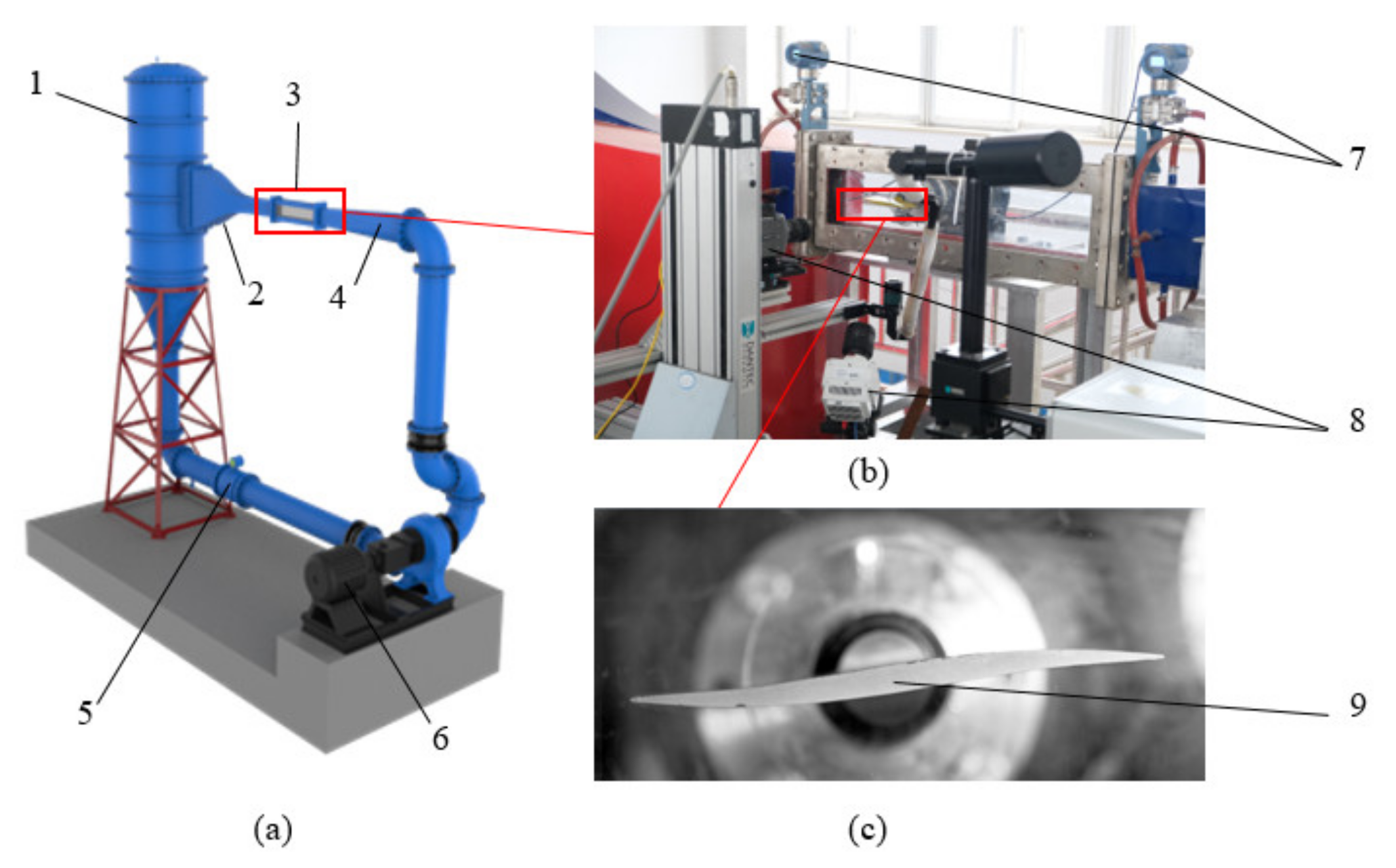
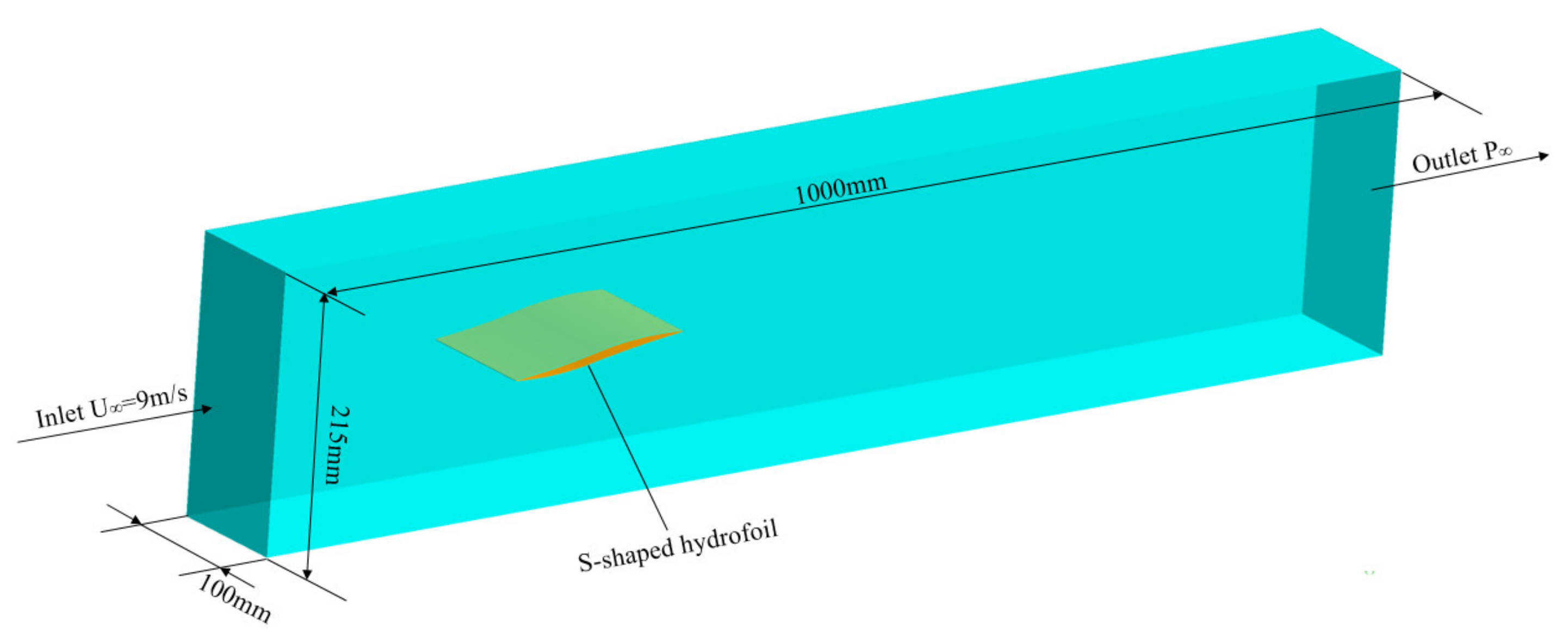

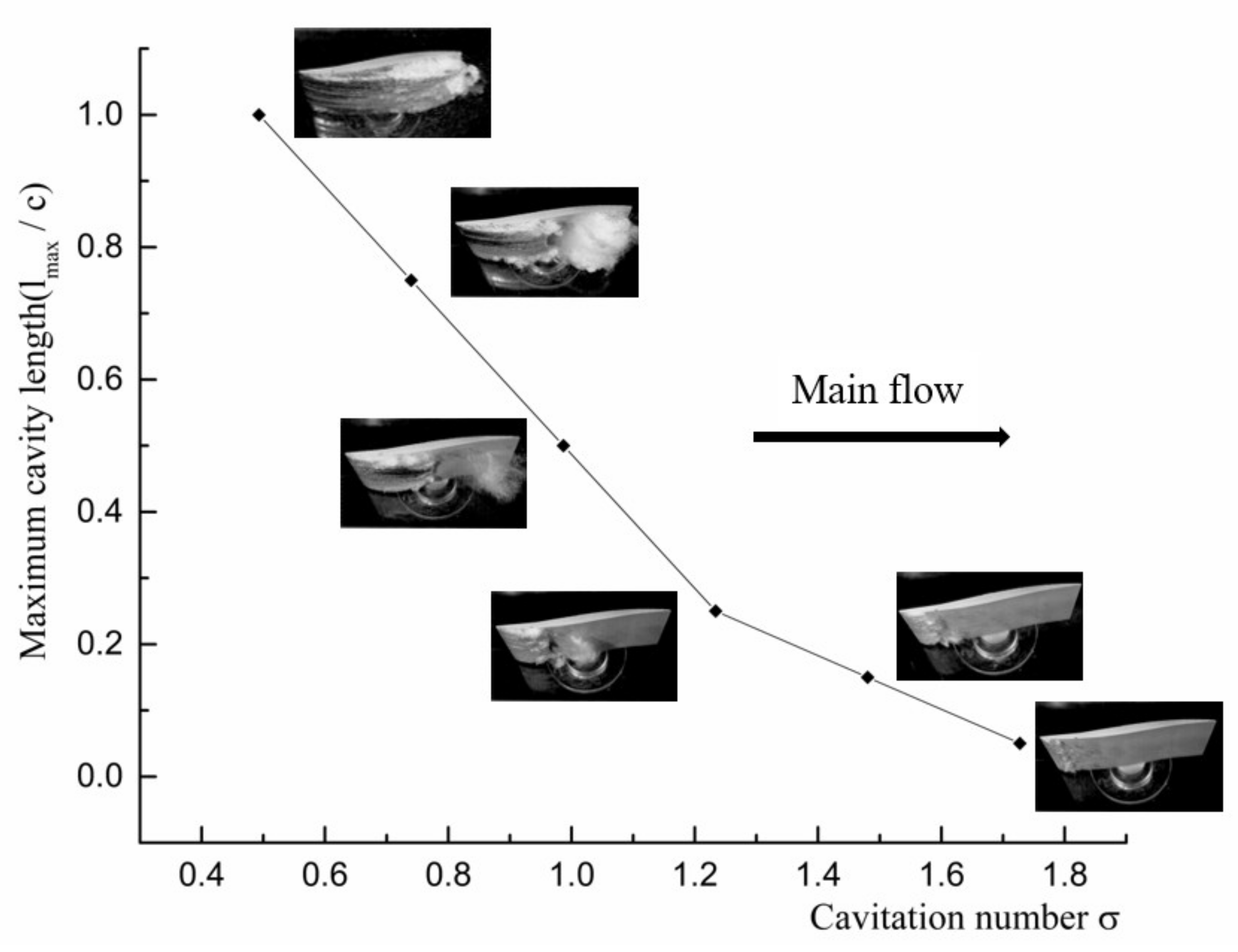
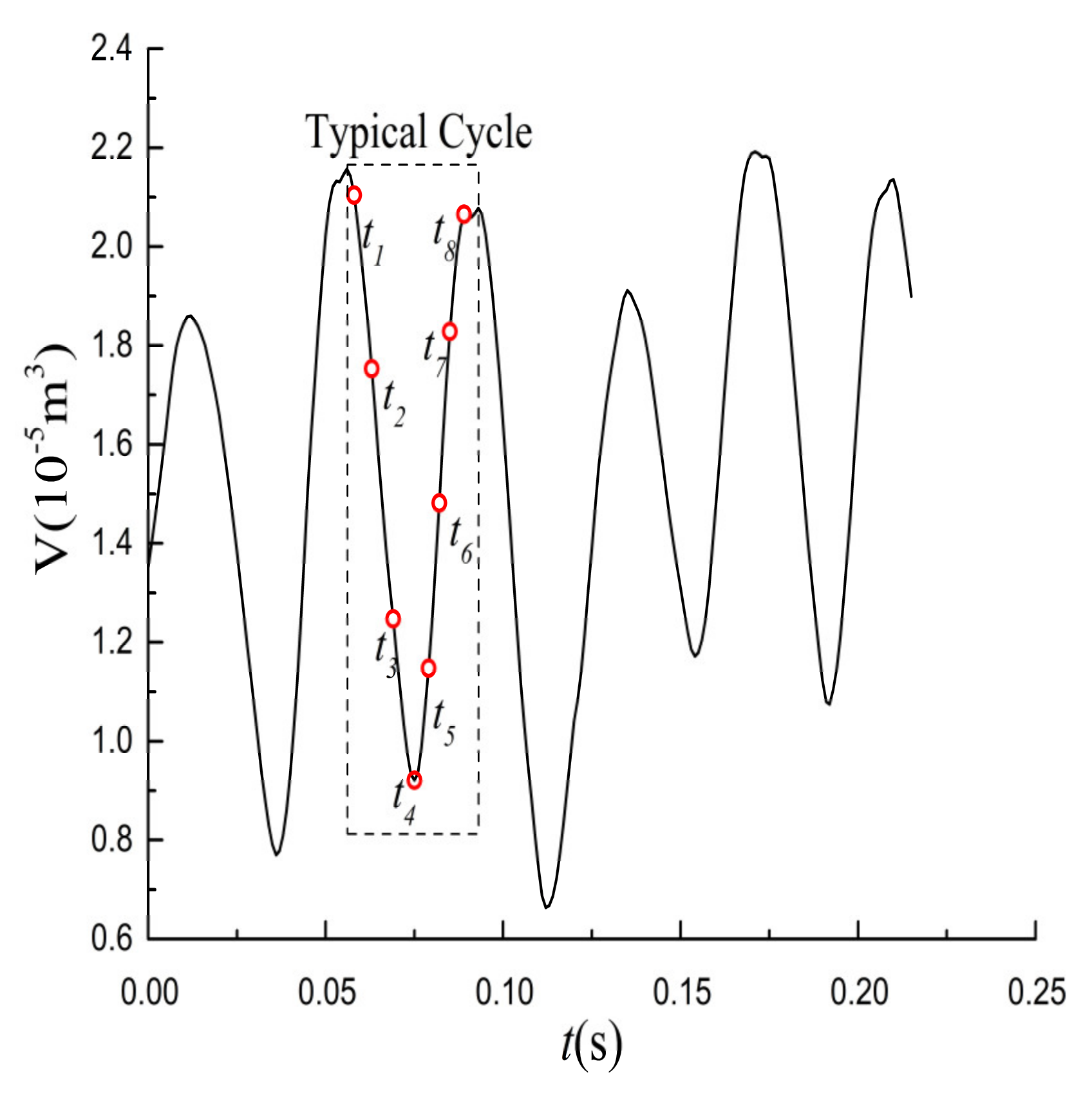
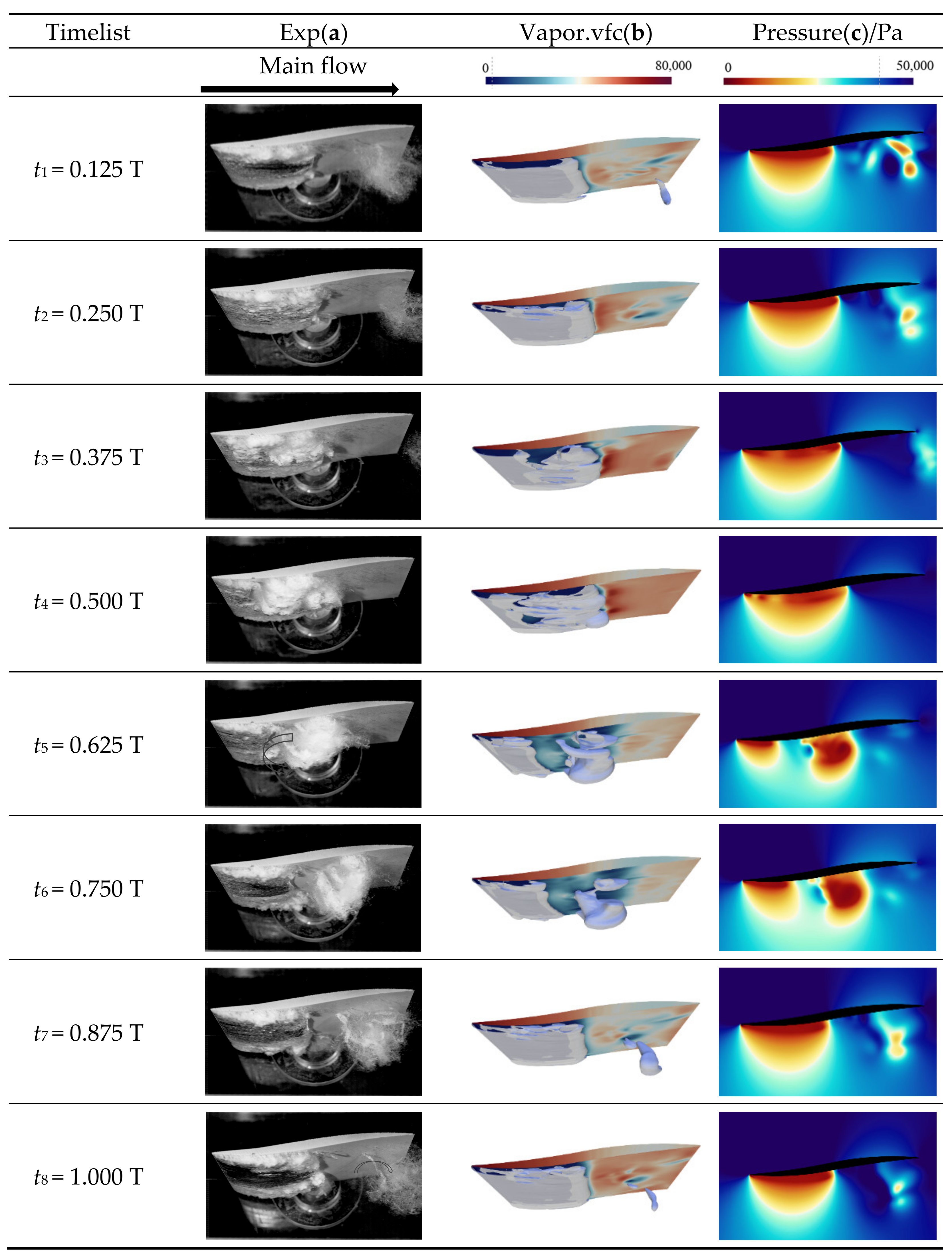
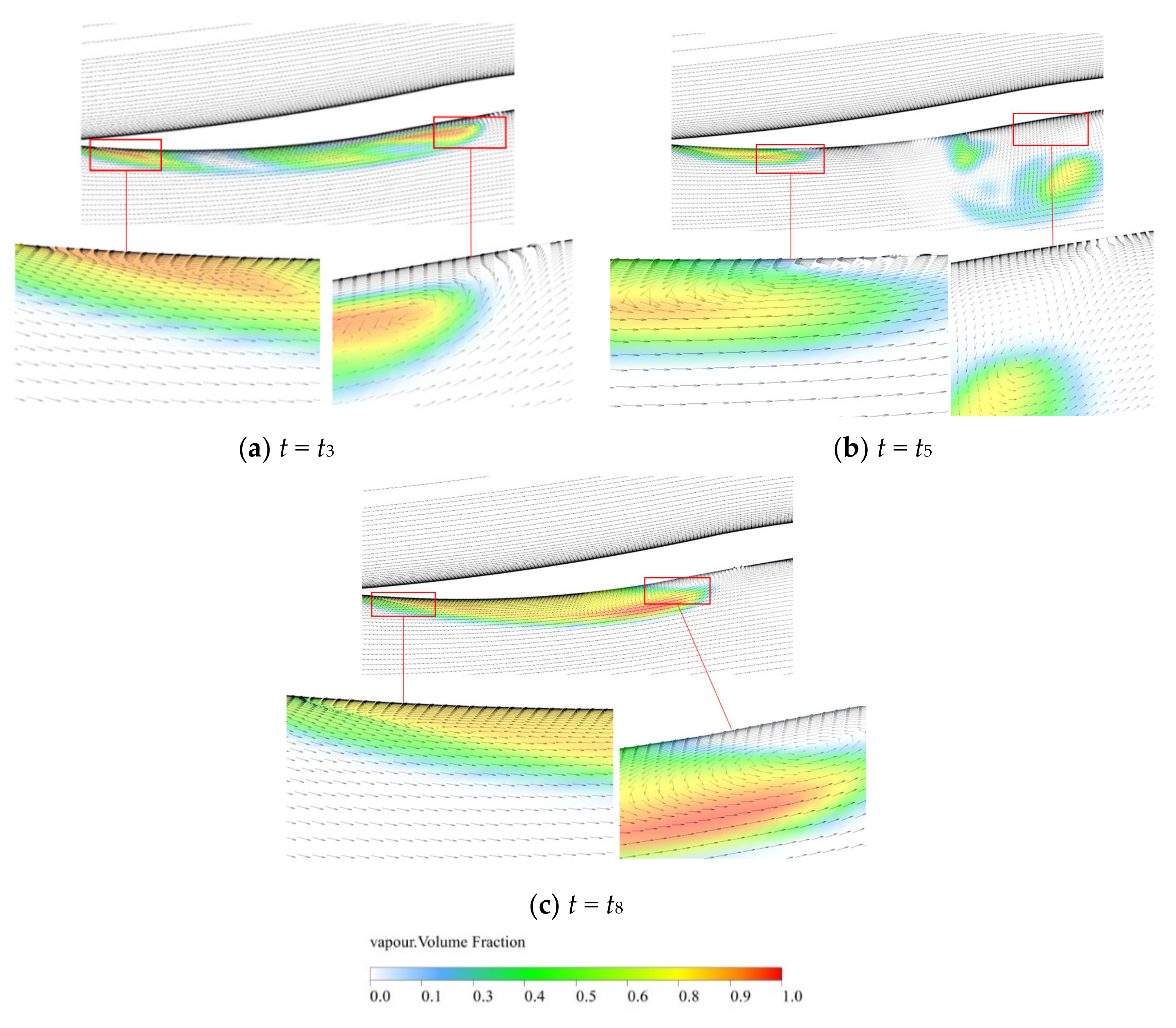
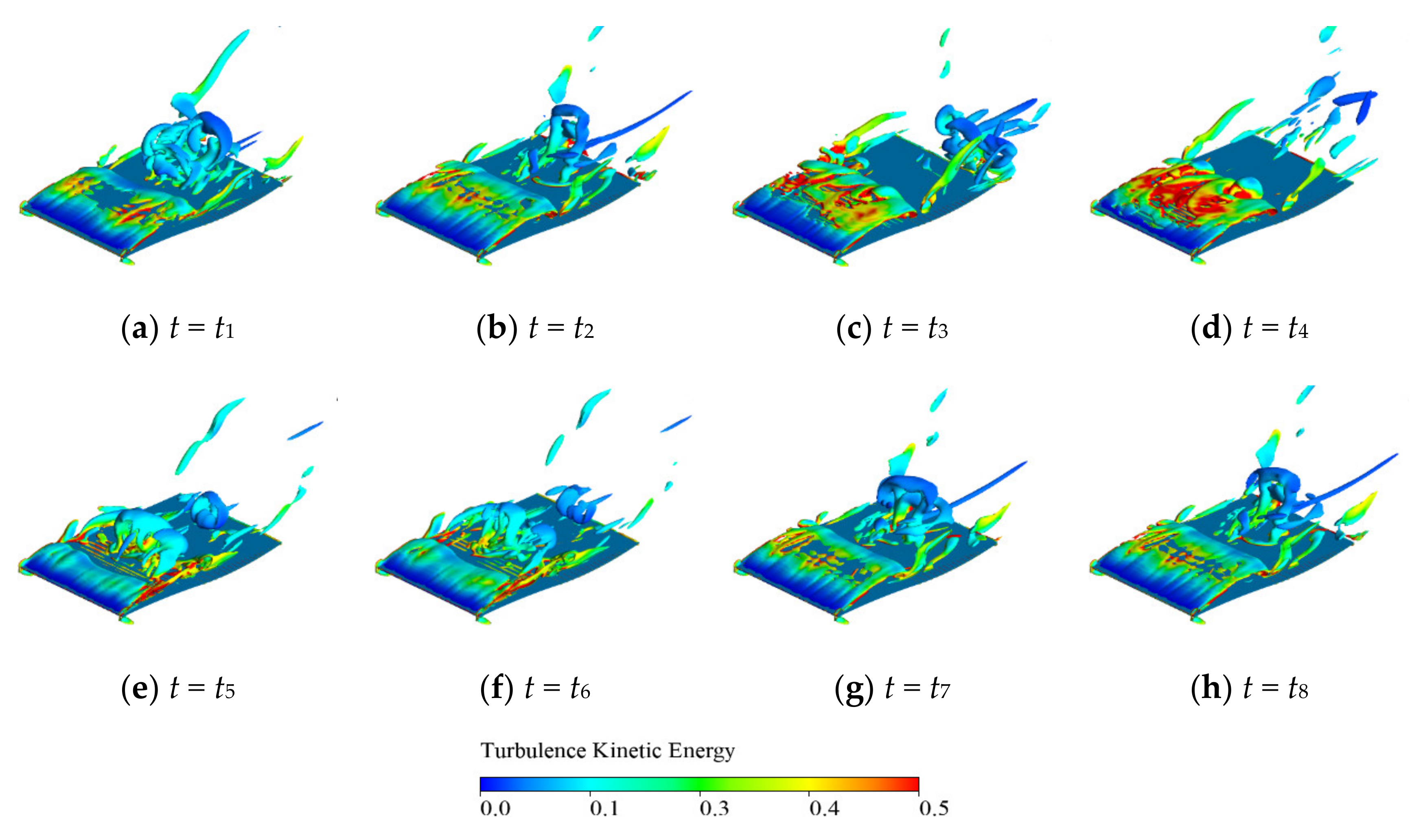
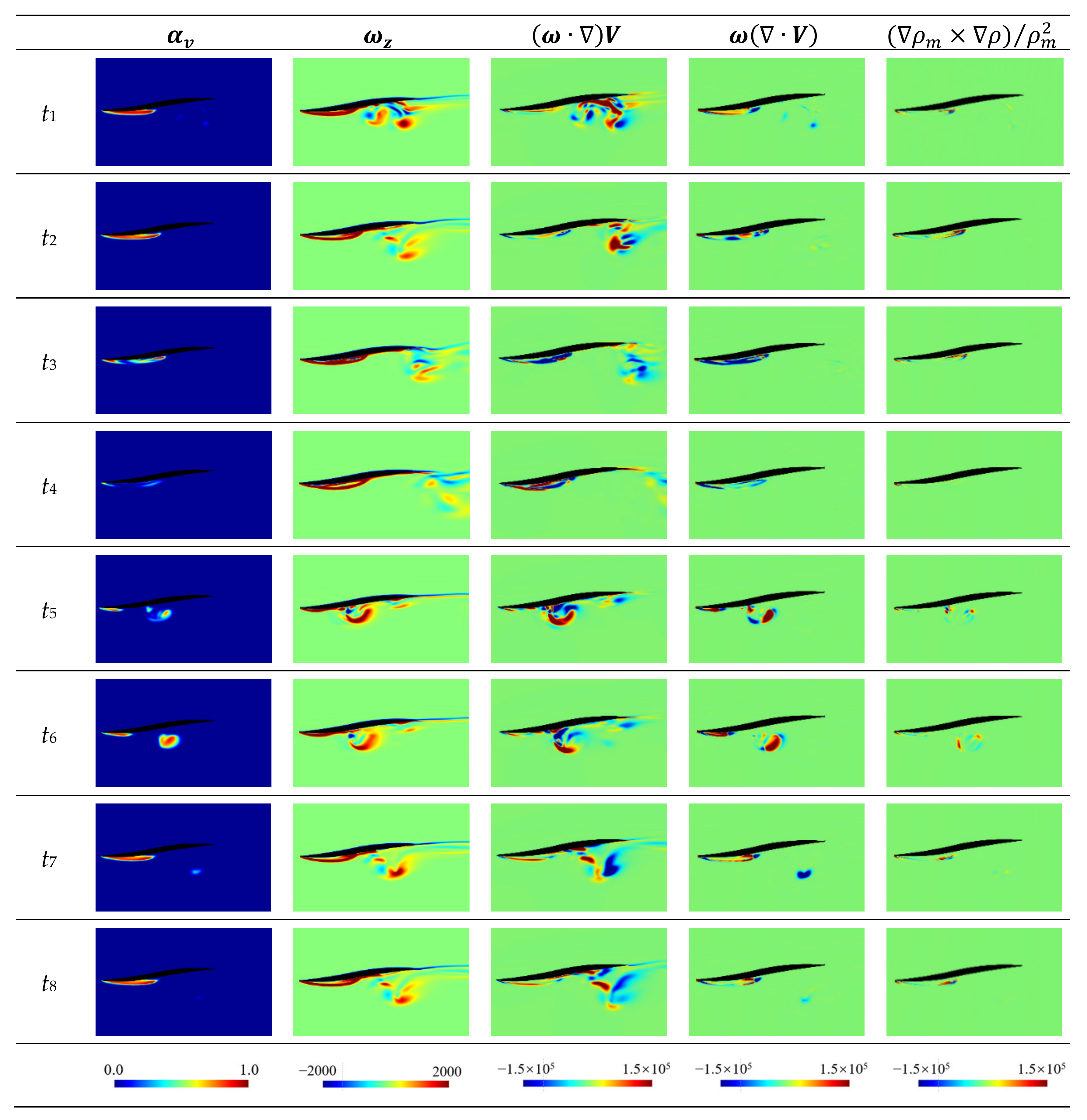

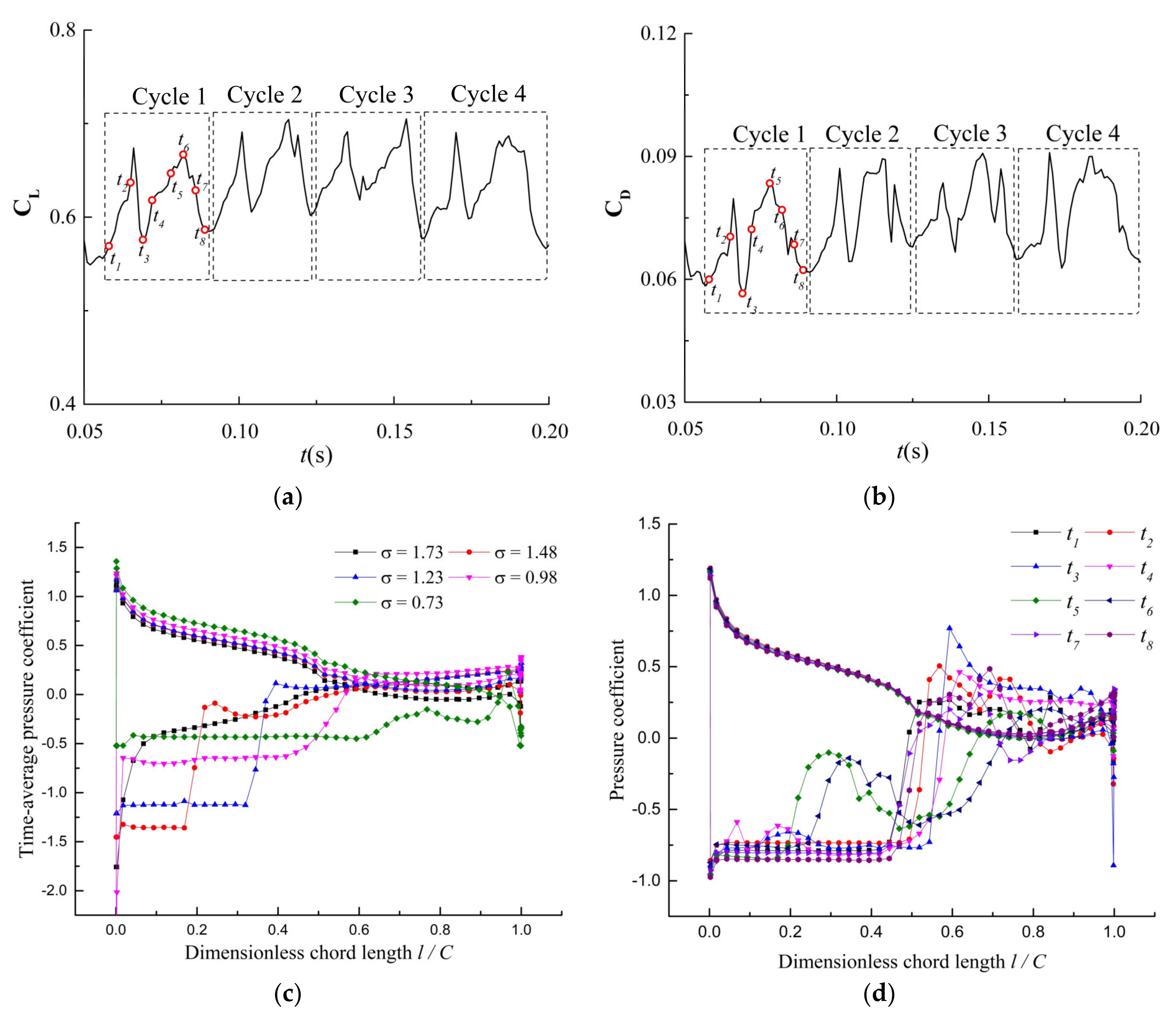
| CL | CD | St | Nodes | |
|---|---|---|---|---|
| Mesh1 | 0.665 | 0.073 | 0.56 | 5388416 |
| Mesh2 | 0.670 | 0.077 | 0.60 | 6386688 |
| Mesh3 | 0.673 | 0.078 | 0.61 | 7432148 |
| Exp | 0.691 | 0.083 | 0.64 |
Publisher’s Note: MDPI stays neutral with regard to jurisdictional claims in published maps and institutional affiliations. |
© 2022 by the authors. Licensee MDPI, Basel, Switzerland. This article is an open access article distributed under the terms and conditions of the Creative Commons Attribution (CC BY) license (https://creativecommons.org/licenses/by/4.0/).
Share and Cite
Liu, H.; Tang, F.; Yan, S.; Li, D. Experimental and Numerical Studies of Cloud Cavitation Behavior around a Reversible S-Shaped Hydrofoil. J. Mar. Sci. Eng. 2022, 10, 386. https://doi.org/10.3390/jmse10030386
Liu H, Tang F, Yan S, Li D. Experimental and Numerical Studies of Cloud Cavitation Behavior around a Reversible S-Shaped Hydrofoil. Journal of Marine Science and Engineering. 2022; 10(3):386. https://doi.org/10.3390/jmse10030386
Chicago/Turabian StyleLiu, Haiyu, Fangping Tang, Shikai Yan, and Daliang Li. 2022. "Experimental and Numerical Studies of Cloud Cavitation Behavior around a Reversible S-Shaped Hydrofoil" Journal of Marine Science and Engineering 10, no. 3: 386. https://doi.org/10.3390/jmse10030386
APA StyleLiu, H., Tang, F., Yan, S., & Li, D. (2022). Experimental and Numerical Studies of Cloud Cavitation Behavior around a Reversible S-Shaped Hydrofoil. Journal of Marine Science and Engineering, 10(3), 386. https://doi.org/10.3390/jmse10030386







